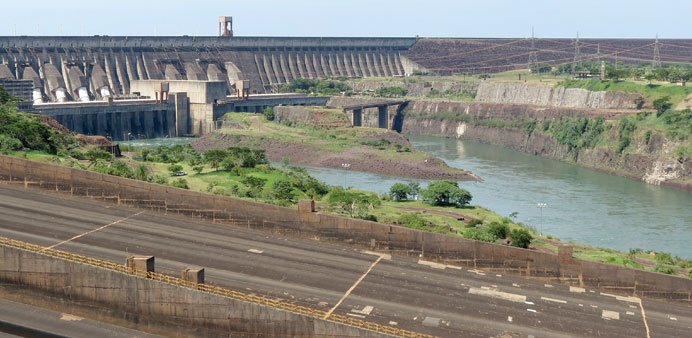MASSIVE: The penstocks and turbine house of the Itaipu Dam, one of the world’s most powerful hydroelectric power sites, in Paraguay. Water runs away at right after driving the turbines.
By Detlef Berg
It’s just a narrow bridge that spans the totally unspectacular Parana river. It connects Foz de Iguacu on the Brazilian side with the Paraguayan city of Ciudad del Este.
It’s hard to believe that the placid waters here will, after just a few more kilometres and a meeting up with the waters of other rivers, spill over the mighty Iguacu Falls on the border of Brazil and Argentina.
Enter Paraguay, a landlocked patch of South America between Brazil, Argentina and Bolivia, and you are on virgin territory in tourist terms. The famous South American places are all abroad. You even have to cross the border out to Brazil to see the Falls.
“Paraguay is unfortunately an unknown country by and large. It’s not on the tourist map,” concedes a local, Gerhard Franz Beyer. “We are a country without sea or white sandy beaches, but with a surprising variety of nature.”
Paraguay does have some technology worth seeing. A few kilometres upstream from Ciudad del Este is an immense hydroelectric power dam, a concrete giant nearly 200 metres high and 8 kilometres long.
The Parana river backs up more than 170 kilometres behind the Itaipu Dam. Its name in the local Tupi language means “the singing stone” and it is one of the largest hydroelectric power dams in the world.
The turbines and penstocks are on Paraguay’s side of the border, though most of the electricity is taken by Brazil.
“It is worth seeing the gigantic power plant,” says Beyer. “It is a joint project of Brazil and Paraguay and there are regular guided tours.” Visitors can go inside the dam and see from close up the 20 huge turbines driven by the plunging water to produce electricity.
Beyer, 68, who runs a hotel and restaurant in Ciudad del Este, is thrilled to receive visitors from far continents.
His accent discloses his Viennese roots. His grandparents came over from Austria, lured by newspaper ads promising European immigrants free land, in 1934.
“They imagined that their beginnings here would be easier than things turned out,” Beyer says, telling his family story over a Vienna-style schnitzel in his hotel’s outdoor restaurant.
His disappointed grandparents didn’t have enough money left over to return to Europe. In 1939 World War Two broke out. So they made do.
They started up a joiner’s workshop and sawmill. After some time, they had enough money left over to start up a restaurant.
Today, Beyer says, “We have a good life here and have put down strong roots.”
There is in fact a waterfall worth seeing inside Paraguay, the Salto del Rio Monday.
“Naturally it can’t compare with the Iguacu, but you can experience this natural setting without all the tourism hassles,” he says.
The next day, a tour of the country with rented cars gets under way, along the Ruta 6 highway. It leads through gently rolling hills, where soybeans are being cultivated left and right and harvested by modern farm equipment.
In the town of Bellavista, Tannia Acosta is waiting for the party. She shows visitors around a mate production facility, pointing out the leaves and stems of the growing mate are plucked, then roasted and ground up to make tea.
“Mate is our national beverage,” Tannia says, offering each visitor a cup. “Not a day goes by here without this thirst-quencher.”
Just a few kilometres from Bellavista are the ruins of the towns of Jesus de Taravanguje and Trinidad de Parana which are on Unesco’s list of world cultural heritage sites.
Between 1608 and 1767, Jesuit priests were active in Paraguay, working to convert the Guarani Indians to Christianity. The Jesuits built over 30 small city-states with the aim of having the Guaranis settle down permanently in them.
In 1767 the king of Spain drove the Jesuits out, because he thought they were becoming too influential. What remains are the impressive ruins of churches, fortifications and residential houses that they had built.
On the road to Asuncion, a side excursion through Caazapa Province leads to Matthias Wagenknecht.
Originally from eastern Germany, Wagenknecht headed to Paraguay to take part in a reforestation project after the Berlin Wall fell in 1989. “Nobody gets an easy break here,” he says. “You have to really work hard.”
Wagenknecht points to a young forest that is a mixture of pine and deciduous trees, and says, “That timber is my capital.”
He also has built the Estancia Curuzua, a little guest house.
If truth be told, there is not a great variety of things for tourists to do in this sparsely populated region.
“If we want to go to the cinema, we have to drive to Ciudad del Este or the capital Asuncion,” he says.
It’s a good 200 kilometres to Asuncion. With some stretches of the highway still unpaved, the trip takes more than three hours.
The capital is a green city that is now in the process of rediscovering its river, the Rio Paraguay. Many ugly buildings on the bank of the river have been torn down, giving way to an attractive riverside promenade.
The imposing government palace is located on the river. The sightseeing attractions of Asuncion are quickly ticked off after the cathedral and the Pantheon, the burial site of the heroes of Paraguay’s war of independence, have been visited.
It is worthwhile to simply stroll through the Plaza de la Democracia with its many souvenir stands. And in the evening, those yearning for a grilled steak will head to one of the many churrascarias, where a range of meats are barbecued churrasco style. —DPA


